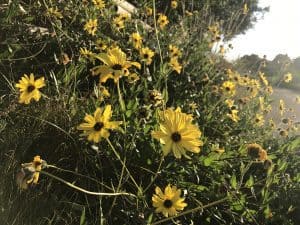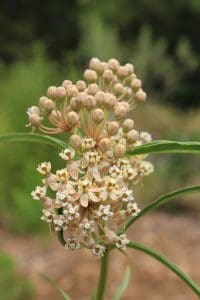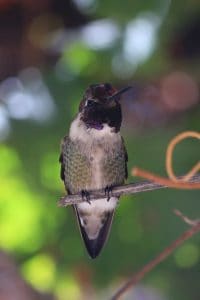May. Post spring? Pre summer? In the Sonoran Desert, the May/June time has a name. It is called the season of “foresummer drought,” signifying the rainless period between the cool Pacific rains of moist winter months, and those of the hot humid summer, when storms thunder in from the south. It certainly seems we are getting hotter and drier. Maybe someday they can expand the boundaries of the Sonoran Desert to include parts of coastal southern California. Baja moves north and Arizona migrates west. For now, your hose provides the summer rain.
In May of last year (2017) we started this publication and the first line read “We have had a fantastic rain year with ample moisture producing one of the best flower seasons ever.” Not so in 2018. Let’s face facts: We have had one of the driest winters on record and with several periods of extreme heat, wind, and at least one hard freeze, our gardens need our help right now in order to be ready for summer. Next rain is obviously not in sight, but theoretically, 5-6 months away. At Tree of Life we had 22” in the 2016/17 and just under 6” this season. Natives in the wild can certainly handle this swing. Hopefully, this newsletter will help gardeners do so as well.

Watering
Definitely time to start your summer watering schedule if you did not do so in April. We simply did not get enough rain to sufficiently infiltrate the soil at the deeper root zones, so you must start locking in some deep moisture now, before the weather and the soils warm up. See our Watering Guide for all the details. There you will learn about cycle/soak watering to provide an “irrigation event” about once a month, interspersed with “refreshing sprinkles” a couple times a week. Combining these easy watering techniques, you will keep good moisture available in the root zone, while occasionally cooling and washing the leaves. Your goal is to apply about 10” total for the entire dry season. This is about one third the amount you would expect to see on a typical “low water use” landscape. Natives work harder on less water, but the watering has to be done correctly. Frequent shallow irrigations, common in gardens everywhere, are not good for native plantings.
Related to Watering
Plants absorb moisture from their roots and transport it through their entire system in order to grow and stay cool. Roots need to find available water and they need oxygen as well. Never hesitate to check the moisture levels of the soil by digging a little hole in an area where you know there are plant roots. If it is dry 4” down, it is time to water thoroughly, with a goal to get water to penetrate 14-18”. The Watering Guide reference above explains how. If the soil is not dry, you do not need to water. Seems obvious. Check your soil visually and by touch.
Pruning
Another way to get ready for summer is to clean up the outside edges of woody shrubs and flowering perennials. No balls, squares, triangles or oddly shaped plants, please. This is a “natural” garden you are tending. Manzanita requires no pruning except light thinning to expose its beautiful branches. Ceanothus can be headed back as if a deer were browsing the new shoots. Other shrubs such as Rhus, Rhamnus, Prunus, Heteromeles, Mahonia, and Myrica should be shaped and thinned to promote good branching and healthy new growth. Subshrubs such as Salvia, Baccharis, and Encelia can be cut back after they bloom. Don’t prune Eriogonum (buckwheat) and other summer flowering plants at this time, as you will trim off all the buds and miss the bloom. Always disinfest your pruning tools with 10% bleach solution, Lysol spray, or rubbing alcohol. Dip between every cut when pruning diseased branches, and periodically as a precaution when cutting healthy wood. You can find more info on May pruning in last year’s newsletter.
Weeding
We have talked a lot about this. Summer weeds may be making an appearance. Presumably you have eliminated the last of the winter weeds.

Mulching/Top dress
See last month’s newsletter. If you choose to add organic mulch or refresh your existing mulch, with summer around the corner, you do not want a fine textured material that will act like compost when it is moist and heated by the sun. You do want a coarse textured bark material, like a mini walk-on bark or mini bark pebbles. You can add a mineral mulch, i.e., pebbles, dg, or rocks, in attractive “drifts” for a very natural look.
Feeding
If you applied fertilizer as directed last month, your garden is set in this department until fall. If not, you can safely feed in May to encourage healthy plants, but you are not trying to produce a lot of artificially exuberant growth. We’re trying to get these plants ready for summer, remember?
Troubleshooting – Varmints, Pests and Diseases
Explosive populations of aphid can occur on spring new growth. Catch them early and blast them off with a hose. Watch for scale and mealybug, especially where you might see Argentine ants on the plant’s branches. Bunnies and ground squirrels are starting to feel the heat, and with fewer forbs, grasses, and weeds around, your garden is looking better all the time. Gophers too. There is no “silver bullet” to deal with these garden invaders. Feel free to write in, explaining your particular situation and we can make a few recommendations.
Annual Wildflowers
The season for planting seed done came and went. If you are enjoying the last of last season’s annual color, you can wait until the plants are dry or nearly so, then mash them up, stomp on them and generally masticate them into “mulch” thereby spreading their seed for next year. Remove any unsightly clumps, especially poppy which might have gotten quite large over the last rainy(?!?) season.
Adding New Plants
Come to Tree of Life to select from a large variety of native plants that love warm season planting. In addition, as you and your garden grow to enjoy a closer relationship, you will start saving seed. Collect from just about anything that meets your fancy. If there is a fleshy fruit, remove it and allow the seeds to dry. You can cut seed stalks of salvia, penstemon, goldenrod, buckwheat, sunflower, and numerous other friends. Turn the dry flower stems upside down in a paper (not plastic) bag. Seed will fall out and can be stored in paper bags, film canisters (remember those?) medicine bottles, yogurt containers, etc. Just keep them cool and dark (your wine cellar is perfect) through summer and spread them where you might want a few volunteers to sprout next fall. No guarantees, but hey, that’s farming.

Engage
Emulate the hummingbirds. They try just about everything. Darting between virtually every flower, they hover long enough to inspect, sample, feed, and revive their frenetic metabolism. This month, in your garden and in your wild travels, try a little of this and a little of that, especially something new. The other day I saw a hummingbird, between penstemon and heuchera visits, stick his beak into a native iris. Probably not his first time, but seeing it was mine. Or maybe it was his as well. I think those little fellows have no fear. You know they dive bomb cats don’t you?
From the Garden, and Foresummer on!
Mike Evans
Questions? Help is just one call or one email away. Call (949) 728-0695 or email (with pictures if you like) our special helpline: gardenhelp@californianativeplants.com